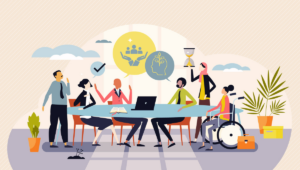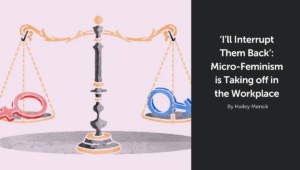Not only are we living through an unprecedented use of the word “unprecedented,” but Google Trend data indicate that “allyship” has been more popular within the last month than at any point since Google started collecting data in 2004.
This is hardly surprising. Following the May 25 murder of George Floyd, millions of Americans—many of them first-time advocates—have begun to wonder how they can best support the Black community, and other under-represented minorities, both at work and in their personal lives.
While there are dozens of definitions of allyship one could follow, our review of the scholarly research has led to one in particular: Allyship is when people are aware that aspects of their identities hold more power and influence than aspects of others’ identities, and use their advantaged position to advocate for people in less advantaged positions.
As the interest in allyship swells, so does the risk for misinterpretation. Which is why we’ve combed through the social and behavioral science literature to try to tell the signal from noise, and collected (and debunked) the three biggest myths around allyship as we see them right now.
Myth #1: Awareness is enough
We can know that we belong to an advantaged group and benefit from the status quo thanks to one or more of our social identities—for example, race, gender, or sexual orientation. And we can know it’s wrong that others suffer an unfair disadvantage because they are members of a group that’s been historically disadvantaged.
Still, we may not be allies.
Among other things, allyship is about taking action to effect real, tangible change—change that is in service of righting injustices. Scholars articulate actions allies can take such as using their voices and advantaged positions to educate fellow advantaged group members who may not be aware that they are unfairly benefitting from a system steeped in inequality. Allies can also engage in actions that illuminate, challenge, and change institutional policies that perpetuate pervasive inequality.
Additionally, scholars highlight that allies can use their access to resources and their social capital to support and advocate for people in less advantaged positions. As an example, researcher Derald Wing Sue and colleagues have outlined strategies to help allies intervene when members from advantaged groups commit racial micro-aggressions against groups of color.
The upshot: Awareness must be coupled with action.
Myth #2: Allyship is friendship
While it may be true that the connections we make through our acts of allyship can lead to friendship, and vice versa, merely having friends from disadvantaged groups doesn’t honor the true definition of allyship. Allyship is about advocacy. It’s about someone in an advantaged position working—on an ongoing basis—to uplift people in less advantaged positions.
Allyship requires an acceptance that two groups face unequal circumstances; the recognition that the ally’s group has more advantages relative to the other group; and the awareness that this imbalance is unjust. Findings from research studies indicate that the way in which advantaged group members perceive their advantage influences their willingness to engage in social action and advocacy.
For example, one research study found that when members of advantaged groups perceived the disadvantage of the other group to be unfair and illegitimate, they were more likely to feel sympathy and share financial resources more equitably, whereas those who viewed their advantage as fair and legitimate were more likely to feel pride about their advantage over others and allot more financial resources to their advantaged group.
The upshot: Friendship is about creating connection. Allyship is about elevating equality.
Myth #3: Once an ally, always an ally
Following a trend on social media or attending a single protest aren’t forms of true allyship. These one-off behaviors fall more into the category of “virtue signaling,” a kind of performative allyship that ignores the ongoing demands in a dynamic and shifting environment.
To be sure, researchers have observed that virtue signaling has the capacity to influence and change social norms. After all, action is still better than inaction, and virtue signalers may indeed be on a good-faith search for how to help.
But for allyship to work in the way it’s intended, it requires consistency, much like a healthy diet requires more than an occasional bowl of granola. It’s the long-term—and sometimes lifelong—practice of taking action with the intention to disrupt a system that advantages some groups over others, as opposed to jumping on a bandwagon for however long that bandwagon is popular.
The upshot: Allyship is built, not attained.
Start building the right habits
To recap, allyship is not merely an interest in helping people from disadvantaged groups. Nor is it the befriending of people in those groups, including them in decision-making, or performing a small collection of acts at one specific time. And it requires ongoing effort and action—a unique blend of empathy, perspective-taking, decisiveness, advocacy, and activism.
At NLI, we’ve been carefully researching the most critical allyship habits to build and talent systems to change, and advising a number of leading organizations on how to approach this. If the Google trend data keep heading the way they’re going, leaders had better get onboard quickly to build these habits. And as with many things today, it pays to follow the science.
[action hash= “a970c252-bb22-42f5-94a3-b51b4777ca4a”]






